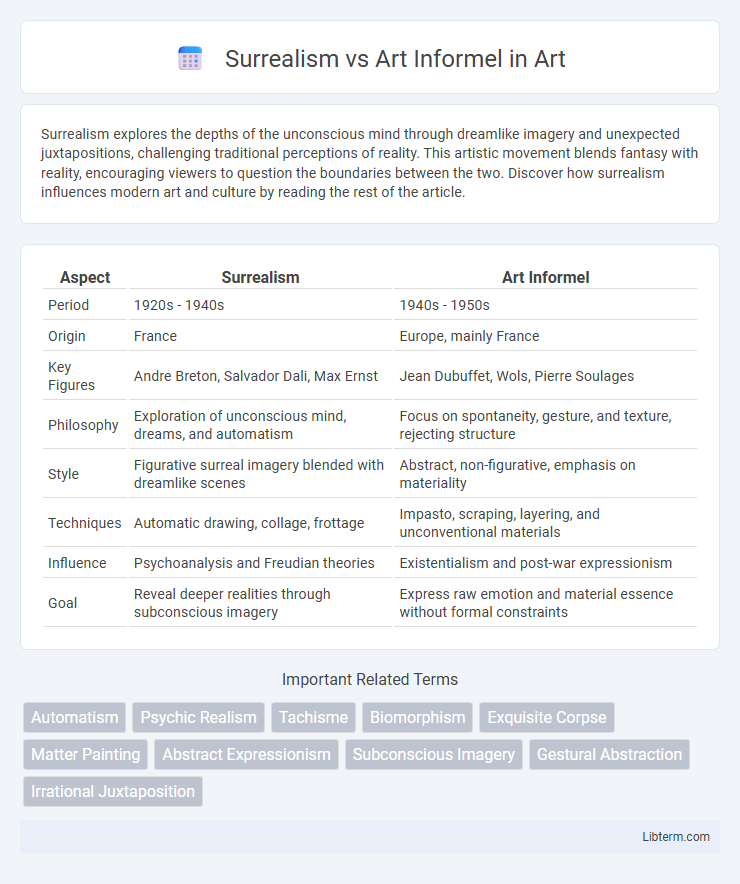Surrealism explores the depths of the unconscious mind through dreamlike imagery and unexpected juxtapositions, challenging traditional perceptions of reality. This artistic movement blends fantasy with reality, encouraging viewers to question the boundaries between the two. Discover how surrealism influences modern art and culture by reading the rest of the article.
Table of Comparison
| Aspect | Surrealism | Art Informel |
|---|---|---|
| Period | 1920s - 1940s | 1940s - 1950s |
| Origin | France | Europe, mainly France |
| Key Figures | Andre Breton, Salvador Dali, Max Ernst | Jean Dubuffet, Wols, Pierre Soulages |
| Philosophy | Exploration of unconscious mind, dreams, and automatism | Focus on spontaneity, gesture, and texture, rejecting structure |
| Style | Figurative surreal imagery blended with dreamlike scenes | Abstract, non-figurative, emphasis on materiality |
| Techniques | Automatic drawing, collage, frottage | Impasto, scraping, layering, and unconventional materials |
| Influence | Psychoanalysis and Freudian theories | Existentialism and post-war expressionism |
| Goal | Reveal deeper realities through subconscious imagery | Express raw emotion and material essence without formal constraints |
Introduction to Surrealism and Art Informel
Surrealism emerged in the early 1920s as an avant-garde movement seeking to unlock the unconscious mind through dream-like imagery and unexpected juxtapositions, pioneered by artists such as Salvador Dali and Andre Breton. Art Informel, developing in post-World War II Europe during the 1940s and 1950s, emphasized spontaneous, non-geometric abstraction, focusing on texture, gesture, and raw expression, with key figures including Jean Dubuffet and Wols. While Surrealism explores symbolic and subconscious themes, Art Informel prioritizes materiality and the improvisational act of painting itself.
Historical Contexts: Origins and Evolution
Surrealism, emerging in the early 1920s in Europe, was deeply rooted in the aftermath of World War I and influenced by Freudian psychoanalysis, emphasizing dream imagery and the unconscious mind. Art Informel developed in the mid-1940s as a post-World War II movement in Europe, reflecting existential angst and a break from traditional forms through spontaneous, gestural abstraction. Both movements evolved in response to the social and political upheavals of their times, with Surrealism focusing on inner realities and Art Informel on raw, unstructured expression.
Philosophical Foundations and Core Ideologies
Surrealism is rooted in the psychoanalytic theories of Freud, emphasizing the unconscious mind, dreams, and automatic writing to unlock deeper realities beyond rational thought. Art Informel rejects traditional forms and rational structures, embracing spontaneity, materiality, and existential freedom, reflecting post-World War II disillusionment and a break from formalist constraints. Both movements challenge conventional aesthetics but diverge philosophically: Surrealism seeks to reveal hidden psychic truths, while Art Informel centers on existential immediacy and the raw gesture as expressions of human experience.
Key Artists and Influential Figures
Surrealism featured key artists like Salvador Dali, Rene Magritte, and Max Ernst, who explored dream-like imagery and the unconscious mind through meticulous techniques. Art Informel included influential figures such as Jean Dubuffet, Wols (Alfred Otto Wolfgang Schulze), and Pierre Soulages, emphasizing spontaneous, gestural abstraction and raw surface textures. Both movements significantly shaped post-war European art, with Surrealism rooted in symbolic representation and Art Informel rejecting formality to embrace existential expression.
Artistic Techniques and Materials Used
Surrealism employs techniques such as automatism, collage, and dreamlike imagery, utilizing materials like oil paints, photomontage elements, and unconventional objects to evoke the unconscious mind. Art Informel emphasizes spontaneous, gestural brushstrokes and texture-rich surfaces, often incorporating mixed media like sand, metal, and fabric fragments to express raw emotion and abstract forms. Both movements challenge traditional artistic boundaries but diverge in their approach--Surrealism explores symbolic narratives, while Art Informel prioritizes materiality and the physicality of paint.
Visual Characteristics: Comparing Aesthetics
Surrealism is characterized by dreamlike imagery, symbolic motifs, and precise, detailed techniques that evoke subconscious exploration and fantastical scenarios. Art Informel features spontaneous, abstract forms with textured surfaces, emphasizing raw emotion through gestural brushstrokes and impromptu composition. Surrealism's clarity contrasts with Art Informel's chaotic, non-representational aesthetics, highlighting a divergence between controlled symbolism and unrestrained expression.
Motifs, Symbols, and Thematic Elements
Surrealism emphasizes dreamlike imagery, automatism, and motifs rooted in the subconscious, such as melting clocks and distorted figures symbolizing psychological conflict and awakening. Art Informel prioritizes spontaneous gestures, abstract forms, and textures that evoke emotional intensity without fixed symbols, often exploring themes of existential anxiety and the chaos of post-war reality. Both movements challenge traditional representation but diverge in Surrealism's focus on symbolic meaning and Art Informel's emphasis on materiality and raw expression.
Impact on Modern and Contemporary Art
Surrealism revolutionized modern art by exploring the subconscious through dream-like imagery and automatism, profoundly influencing contemporary artists seeking psychological depth and symbolic complexity. Art Informel, characterized by spontaneous, gestural abstraction and material experimentation, challenged traditional forms and paved the way for post-war expressionism and action painting. Both movements expanded artistic boundaries, fostering innovations in visual language that continue to shape Modern and Contemporary Art practices worldwide.
Critical Reception and Academic Debates
Surrealism and Art Informel sparked divergent critical reception, with Surrealism praised for its exploration of the unconscious and dream imagery, while Art Informel was often debated for its abstract, spontaneous techniques challenging traditional aesthetics. Academic debates center on Surrealism's roots in psychoanalysis and political activism versus Art Informel's emphasis on materiality and existential expression in post-war Europe. Scholars continue to analyze how both movements influenced modern art, highlighting their distinct contributions to visual language and cultural critique.
Surrealism vs Art Informel: Lasting Legacies
Surrealism's lasting legacy lies in its profound influence on the subconscious exploration of dream imagery and the liberation of creative expression, inspiring diverse artistic movements and contemporary psychology. Art Informel, on the other hand, reshaped post-war European abstraction through its emphasis on spontaneity, materiality, and emotional intensity, paving the way for Tachisme and Abstract Expressionism. Both movements fundamentally challenged traditional aesthetics, leaving enduring impacts on visual culture and modern art theory.
Surrealism Infographic

 libterm.com
libterm.com